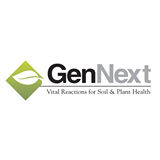WE WILL BE AT STONE HARBOR ON THURSDAY THSI WEEK FOR "THE WAR ON THE SHORE" JOINT GCSAA EVENT.
GenNext Observations
Looking at some of the greens a little more closely this morning where we have applied GenNext Complete A & B, I have made a few observations.
So far the "GenNext greens" have had a total of .8# N/m applied to them and the check plots are at .3# N/m. This is much more nitrogen then we are use to applying at this point in the growing season. We are typically around .3#-.5# N/m at this point. With that said, we have noticed the greens where we have had a moss infestation, such as holes #2, #3, the moss in the check plot areas seems to have a green color and only has a few bentgrass/poa plants emerging through the moss. Where as the rest of the green surface where the GenNext has been applied is showing more bentgrass plants especially emerging through the moss. The moss also seems to be "suppressed" and not as active as the check plots. This can be attributed to the increased level of nitrogen that the greens have received that we tend not to apply at this point.
The second observation is the rooting depth in both the check plot areas and GenNext applied areas appear to be the same at about a 3-4" depth.
The third observation made is the clipping yield from the "GenNext greens" to the "non-GenNext greens" is approximately the same. The "non-GenNext" greens have a total of .675# N/m applied to them of ammonium sulfate. With .8# N/m applied in one month you would expect a dark green color on the greens which we have seen. However the growth seems to be more lateral then upright which is desired to help encourage more bentgrass into the putting surface.
Our last observation made is with the warmer temperatures we have had we have had poa annua seed heads emerge on the putting surfaces. Even though we made a seed head suppression application 3 weeks ago, our timing has seemed to be off, which is disappointing. However, the "GenNext greens" have significantly less seed heads then the "non-GenNext" greens. The only difference in applications besides amount of nitrogen is the applications of GenNext Complete A & B.
To also note the soil temperatures in the greens as of today is 60 degrees at a 2" depth and 58 degrees at a 4" depth.
 |
| Moss in the GenNext Complete A & B area on #3 green |
 |
| Moss within the check plot on #3 green |
